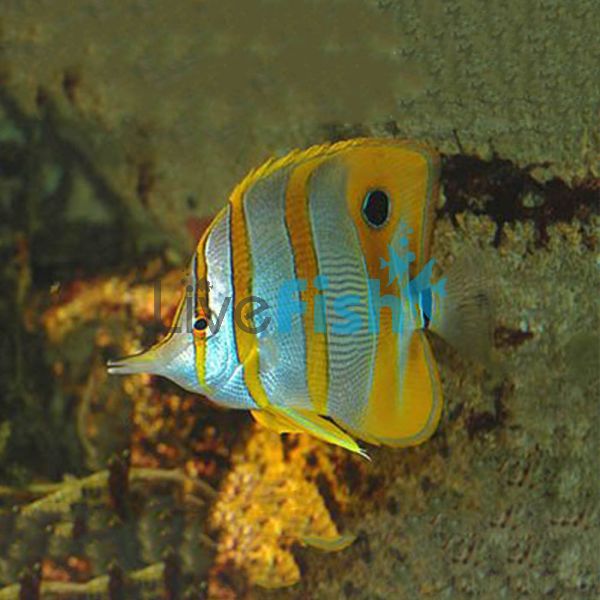Copperband Butterflyfish - Medium
The Copperbanded Butterflyfish has a silvery white body with four vertical orange bands with a blackish edge. The first of these passes through the eye and also has a black spot at the top rear end of it’s body and a long protruding snout tipped with a small mouth.
Butterflyfish Copperband
They are territorial fish, laying their eggs amongst the reefs and display vertical white with copper stripes with a false eye on the dorsal fin and measuring up to 8 inches in length.
The level of difficulty will depend on the individual specimen itself. These fish are best left to advanced aquarium enthusiasts and not recommended for beginners due to their daily diet requirements.
The Copperband Butterflyfish will play nicely in a community tank but avoid keeping with other butterflyfish unless they are already an established pair.
The Copperband Butterflyfish lives on the coral reefs, rocky shorelines, estuaries, and inner reefs in the Pacific and Indian Oceans. Their range stretches from Australia to Indonesia, the Philippines, and Singapore.
Before adding the fish to your tank, keep it in a quarantine tank to avoid introducing any possible parasites or pathogens to other fish. This will also offer ample time to verify which type of food your Copperband prefers by offering it a variety.
Tank Recommendations for Copperband Butterflyfish
This fish likes plenty of live rock to hide in and can be a bonus to have in a reef tank if you have a problem with Aiptasia species like the Glass Anemone as they love to eat these. They may also nip on the large polyp stony corals. It does like a mixture of corals and sands as substrate and for a single individual required a tank of a minimum of 70 gallons.
This fish does spend a lot of its time swimming freely and so appreciated some open spaces, but it does also like to hide in crevices between corals and rocks. Flowing water isn’t a must for this fish, but it does like a gentle flow of water, but not a strong current.
They are best kept in at least 265 litres (70gal) tanks with live rock and corals for feeding with excellent water filtration that is UV sterilized and parasite-free.
Suitable Tank Buddies
The Copperband Butterflyfish compatibility does vary from individual to individual with many aquarists reporting that their Copperband’s have been no problems at all in reef tanks when fed adequately. However other people have reported that some individuals have become very territorial and not mixed well with other tankmates.
Usually Compatible
Good candidates as tank mates include smaller non-aggressive fishes like Cardinalfish, Gobies, Tilefish, Fairy Basslets, fairy and flasher wrasses, and sometimes other species of Butterflyfish.
Sometimes Compatible
This Butterflyfish whilst usually peaceful can occasionally become aggressive and territorial especially with other members of the same species and sometimes other members of the same fish family. It generally doesn’t mix well with aggressive fish such as Tangs and Damselfish even when they are smaller than the Butterflyfish. Usually, it’s okay with Clownfish Dwarf Angelfish, large Wrasses, Shrimps, Crabs, Starfish, and Snails but watches how they go.
Rarely Compatible
These fish shouldn’t be kept with Lionfish, Groupers, Sharks, or Rays as they may be eaten by them and they shouldn’t be kept with Seahorses or Pipefish, or other slow swimmers as the slow swimming fish will not be able to compete for food with the Butterflyfish.
Feeding Your Copperband Butterflyfish
In the wild, the Copperband use their long narrow beaks to hunt for food in crevices, holes, and gaps between rocks or coral.
They feed on benthic invertebrates, glass anemones (Aiptasia), polychaete tubeworms, small crustaceans, and sometimes coral polyps.
Feeding these fish in an aquarium can be a more difficult task, especially when first introduced to a tank, and will require live foods before the switch to frozen or flake foods.
Experimentation will prove best for your Copperband and brine or Mysis shrimp are a good place to start.
Provided they have adequate food to choose from and consistency they will play well with other fishes and you should be able to mix in pellets and flake foods into their diet.
As adults they should be fed twice a day, as juveniles, they should be fed 3 to 4 times a day.
| Scientific Name | Chelmon Rostratus |
|---|---|
| Care Level | Moderate |
| Common Names | Copperband Butterflyfish, Beaked Butterflyfish, Long-Nosed Butterflyfish, Beaked Coralfish, Orange-Stripe Butterflyfish. |
| Diet | Carnivore |
| Fish Family | Chaetodontidae |
| Lifespan (years) | 8 |
| Max. Length (cm) | 20 |
| Min. Tank Volume (l) | 470 |
| Origin | Indo-Pacific |
| Reef Safe | With Caution |
| Sociability | Peaceful |
| Venomous | No |
| Water Conditions | 22 - 25° C, dKH 8 - 12, pH 8.1- 8.4, sg 1.020 -1.025 |




